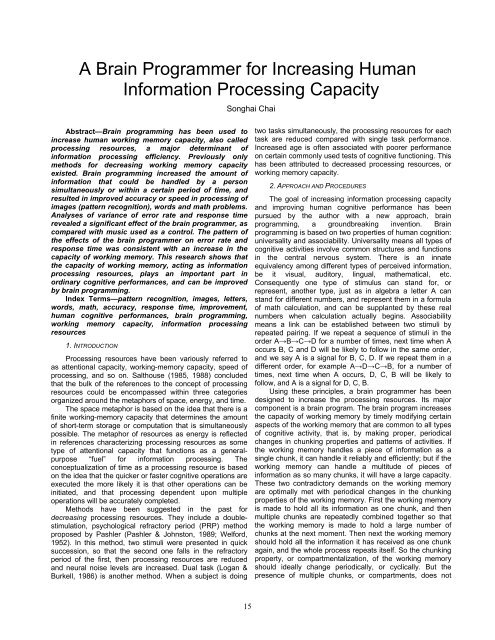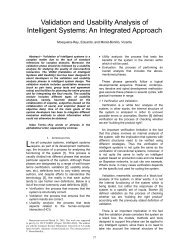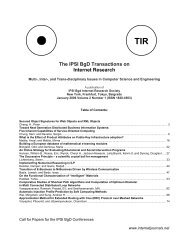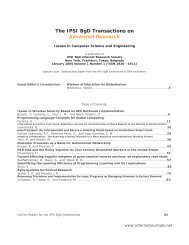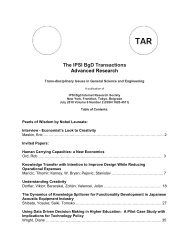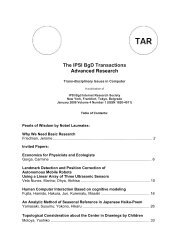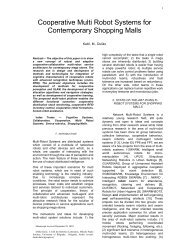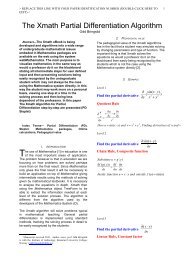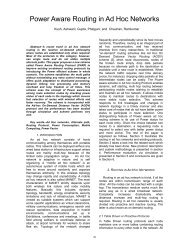A Brain Programmer for Increasing Human Information Processing ...
A Brain Programmer for Increasing Human Information Processing ...
A Brain Programmer for Increasing Human Information Processing ...
You also want an ePaper? Increase the reach of your titles
YUMPU automatically turns print PDFs into web optimized ePapers that Google loves.
A <strong>Brain</strong> <strong>Programmer</strong> <strong>for</strong> <strong>Increasing</strong> <strong>Human</strong><br />
In<strong>for</strong>mation <strong>Processing</strong> Capacity<br />
Songhai Chai<br />
Abstract—<strong>Brain</strong> programming has been used to<br />
increase human working memory capacity, also called<br />
processing resources, a major determinant of<br />
in<strong>for</strong>mation processing efficiency. Previously only<br />
methods <strong>for</strong> decreasing working memory capacity<br />
existed. <strong>Brain</strong> programming increased the amount of<br />
in<strong>for</strong>mation that could be handled by a person<br />
simultaneously or within a certain period of time, and<br />
resulted in improved accuracy or speed in processing of<br />
images (pattern recognition), words and math problems.<br />
Analyses of variance of error rate and response time<br />
revealed a significant effect of the brain programmer, as<br />
compared with music used as a control. The pattern of<br />
the effects of the brain programmer on error rate and<br />
response time was consistent with an increase in the<br />
capacity of working memory. This research shows that<br />
the capacity of working memory, acting as in<strong>for</strong>mation<br />
processing resources, plays an important part in<br />
ordinary cognitive per<strong>for</strong>mances, and can be improved<br />
by brain programming.<br />
Index Terms—pattern recognition, images, letters,<br />
words, math, accuracy, response time, improvement,<br />
human cognitive per<strong>for</strong>mances, brain programming,<br />
working memory capacity, in<strong>for</strong>mation processing<br />
resources<br />
1. INTRODUCTION<br />
<strong>Processing</strong> resources have been variously referred to<br />
as attentional capacity, working-memory capacity, speed of<br />
processing, and so on. Salthouse (1985, 1988) concluded<br />
that the bulk of the references to the concept of processing<br />
resources could be encompassed within three categories<br />
organized around the metaphors of space, energy, and time.<br />
The space metaphor is based on the idea that there is a<br />
finite working-memory capacity that determines the amount<br />
of short-term storage or computation that is simultaneously<br />
possible. The metaphor of resources as energy is reflected<br />
in references characterizing processing resources as some<br />
type of attentional capacity that functions as a generalpurpose<br />
“fuel” <strong>for</strong> in<strong>for</strong>mation processing. The<br />
conceptualization of time as a processing resource is based<br />
on the idea that the quicker or faster cognitive operations are<br />
executed the more likely it is that other operations can be<br />
initiated, and that processing dependent upon multiple<br />
operations will be accurately completed.<br />
Methods have been suggested in the past <strong>for</strong><br />
decreasing processing resources. They include a doublestimulation,<br />
psychological refractory period (PRP) method<br />
proposed by Pashler (Pashler & Johnston, 1989; Wel<strong>for</strong>d,<br />
1952). In this method, two stimuli were presented in quick<br />
succession, so that the second one falls in the refractory<br />
period of the first, then processing resources are reduced<br />
and neural noise levels are increased. Dual task (Logan &<br />
Burkell, 1986) is another method. When a subject is doing<br />
two tasks simultaneously, the processing resources <strong>for</strong> each<br />
task are reduced compared with single task per<strong>for</strong>mance.<br />
Increased age is often associated with poorer per<strong>for</strong>mance<br />
on certain commonly used tests of cognitive functioning. This<br />
has been attributed to decreased processing resources, or<br />
working memory capacity.<br />
2. APPROACH AND PROCEDURES<br />
The goal of increasing in<strong>for</strong>mation processing capacity<br />
and improving human cognitive per<strong>for</strong>mance has been<br />
pursued by the author with a new approach, brain<br />
programming, a groundbreaking invention. <strong>Brain</strong><br />
programming is based on two properties of human cognition:<br />
universality and associability. Universality means all types of<br />
cognitive activities involve common structures and functions<br />
in the central nervous system. There is an innate<br />
equivalency among different types of perceived in<strong>for</strong>mation,<br />
be it visual, auditory, lingual, mathematical, etc.<br />
Consequently one type of stimulus can stand <strong>for</strong>, or<br />
represent, another type, just as in algebra a letter A can<br />
stand <strong>for</strong> different numbers, and represent them in a <strong>for</strong>mula<br />
of math calculation, and can be supplanted by these real<br />
numbers when calculation actually begins. Associability<br />
means a link can be established between two stimuli by<br />
repeated pairing. If we repeat a sequence of stimuli in the<br />
order A→B→C→D <strong>for</strong> a number of times, next time when A<br />
occurs B, C and D will be likely to follow in the same order,<br />
and we say A is a signal <strong>for</strong> B, C, D. If we repeat them in a<br />
different order, <strong>for</strong> example A→D→C→B, <strong>for</strong> a number of<br />
times, next time when A occurs, D, C, B will be likely to<br />
follow, and A is a signal <strong>for</strong> D, C, B.<br />
Using these principles, a brain programmer has been<br />
designed to increase the processing resources. Its major<br />
component is a brain program. The brain program increases<br />
the capacity of working memory by timely modifying certain<br />
aspects of the working memory that are common to all types<br />
of cognitive activity, that is, by making proper, periodical<br />
changes in chunking properties and patterns of activities. If<br />
the working memory handles a piece of in<strong>for</strong>mation as a<br />
single chunk, it can handle it reliably and efficiently; but if the<br />
working memory can handle a multitude of pieces of<br />
in<strong>for</strong>mation as so many chunks, it will have a large capacity.<br />
These two contradictory demands on the working memory<br />
are optimally met with periodical changes in the chunking<br />
properties of the working memory. First the working memory<br />
is made to hold all its in<strong>for</strong>mation as one chunk, and then<br />
multiple chunks are repeatedly combined together so that<br />
the working memory is made to hold a large number of<br />
chunks at the next moment. Then next the working memory<br />
should hold all the in<strong>for</strong>mation it has received as one chunk<br />
again, and the whole process repeats itself. So the chunking<br />
property, or compartmentalization, of the working memory<br />
should ideally change periodically, or cyclically. But the<br />
presence of multiple chunks, or compartments, does not<br />
15
necessarily mean every one of them is actively holding a<br />
piece of in<strong>for</strong>mation, or is turned on. As the periodical<br />
changes of chunking properties goes from cycle to cycle,<br />
new in<strong>for</strong>mation gradually fills up, or turns on, larger and<br />
larger proportion of the multitude of available compartments,<br />
giving rise to a gradually changing “pattern of activities” in<br />
the working memory. When most of the compartments are<br />
filled up, they should be emptied out, or turned off again, to<br />
make room <strong>for</strong> new in<strong>for</strong>mation. So the proportion of active<br />
compartments of successive patterns of activities in the<br />
working memory should increase gradually and then drop<br />
abruptly in a periodical manner. And this period is longer<br />
than the period in the cyclic changes in chunking property, or<br />
compartmentalization, since it takes a number of cycles in<br />
the periodical changes in compartmentalization to fill up a<br />
multitude of compartments and complete one cycle in the<br />
periodical changes in the pattern of activities.<br />
To properly guide the two periodical changes, computergenerated<br />
sound signals (or stimuli) are arranged in a brain<br />
program, recorded on an audio-recording device, played<br />
back and heard by a person, and thus stored in his/her longterm<br />
memory (LTM). Later, the memorized stimuli of the<br />
brain program are recalled subliminally from LTM. The<br />
process of memorizing and recalling the brain program is<br />
automatic without the person knowing it or making any ef<strong>for</strong>t.<br />
Some stimuli in the brain program are surrogates <strong>for</strong> pieces<br />
of in<strong>for</strong>mation to be processed and, when recalled during<br />
cognitive per<strong>for</strong>mance, will be supplanted by these pieces of<br />
in<strong>for</strong>mation to be processed. Other stimuli are put in such<br />
places in the brain program, <strong>for</strong> example just be<strong>for</strong>e a<br />
surrogate stimulus, that, when recalled, they will be<br />
associated with these pieces of in<strong>for</strong>mation to be processed<br />
through conditioning, and thus become signals, or “carriers”,<br />
<strong>for</strong> these in<strong>for</strong>mation being processed. The stimuli in the<br />
brain program are arranged in such a way as to enable<br />
pieces of in<strong>for</strong>mation being processed, when they have<br />
supplanted their surrogates and become inserted in the brain<br />
program, to interact with each other, thus achieving the<br />
periodical changes in chunking property and in patterns of<br />
activities in the working memory. These sound signals are<br />
short music tones generated by a computer, are identified by<br />
their pitch (frequencies), and are the main part of a brain<br />
program that is called a computerized auditory brain<br />
program (CABP), which also includes verbal signals.<br />
The memory of CABP has to be recalled subconsciously<br />
at a faster speed than the speed at which it was presented to<br />
a person. That is, the recalled CABP has to be instantiated,<br />
as all the steps in a cycle of CABP have to be recalled into a<br />
person’s mind in an instant, if they are to have any effects on<br />
the ongoing in<strong>for</strong>mation processing. Instantiation of recalled<br />
CABP is facilitated by a trick in the way CABP is presented<br />
and stored in the long-term memory. During CABP<br />
presentation, two identical sequences of sound signals are<br />
presented, the first at a lower speed and the second at a<br />
higher speed. The difference in speed is small enough to<br />
make the two sequences sound like the same so that the<br />
long-term memory will hold a single copy of the sequence,<br />
but big enough to make the time taken by the two sequences<br />
indefinite in the long-term memory. That is, the two<br />
sequences are fused into one sequence in the long-term<br />
memory (LTM) that keeps the characteristics, such as pitch<br />
of a sound signal and sound-duration-to-interval ratio, that<br />
are the same in the original two sequences and thus<br />
strengthen each other in the LTM, but loses characteristics,<br />
such as speed and time taken, that are different <strong>for</strong> the two<br />
original sequences and thus cancel each other out in the<br />
LTM. Then the time taken by the recalled brain program will<br />
have to be determined anew. In the two sequences, the<br />
in<strong>for</strong>mation about the time taken by a cycle is loaded onto a<br />
very short time period that is embodied in intervals between<br />
repeating signals. As a result the brain program is recalled at<br />
a speed much higher than the speed of either of the two<br />
original sequences. Thus instantiation is achieved, and a<br />
cycle of different steps takes only an instant to complete. As<br />
a result, a large amount of processing resources is always<br />
available to receive and process new in<strong>for</strong>mation. So CABP<br />
actually contains two sequences of sound signals, but they<br />
result in one brain program.<br />
Besides the brain program CABP, the other major<br />
component of the brain programmer is a rein<strong>for</strong>cement<br />
system. The rein<strong>for</strong>cement system uses single brief vibratory<br />
signals to refresh the memory of CABP over time. Actually it<br />
is the lengths of intervals between discrete vibratory pulses<br />
that are being used as signals which are associated with<br />
CABP through conditioning and there<strong>for</strong>e subsequently<br />
arouse the memory of CABP. The intervals between discrete<br />
vibratory pulses are stronger signals than the pulses<br />
themselves. These intervals are easy to manipulate. A time<br />
interval T can be halved to another interval T/2, or give rise<br />
to T/3 or T/4. These slightly changed versions, when<br />
presented, will resonate with the memory of the original T,<br />
and there<strong>for</strong>e can be used in place of T, which has been<br />
associated with CABP, thus avoiding undesirable repetition<br />
of a single time interval as a signal, which would weaken the<br />
association between the signal and the event it evokes. In<br />
the rein<strong>for</strong>cement system these modified versions of a time<br />
interval T are incorporated into a sequence of single brief<br />
vibratory pulses whose intervals range from under 20<br />
seconds to over a minute. When used in conjunction with<br />
CABP, the rein<strong>for</strong>cement system first gives a single vibratory<br />
pulse at both the beginning and end of a time interval T in<br />
the CABP that contains a number of repetitions of a verbal<br />
signal, “now start”, which has been associated with the main<br />
part of CABP during its playback. After CABP playback has<br />
ended and the person is per<strong>for</strong>ming cognitive tasks with<br />
increased processing resources, the rein<strong>for</strong>cement system<br />
continues to give this person a sequence of vibratory pulses<br />
whose intervals are related to interval T in different ways<br />
(T/3, T/4, etc) as mentioned above. The recalled memory of<br />
the interval T elicits the memory of those repetitions of the<br />
verbal signal, each of which in turn contributes a<br />
strengthening effect to the memory of the brain program<br />
CABP. Thus the memory of CABP is constantly refreshed<br />
and its effectiveness maintained over time.<br />
Since the brain programmer has its effects on the most<br />
basic properties of cognitive functioning, it can be used to<br />
improve all kinds of cognitive per<strong>for</strong>mances.<br />
3. PRELIMINARY STUDIES:<br />
Predictions based on metaphors of processing<br />
resources as space, time, and energy:<br />
1. Letter match with short exposure time.<br />
The visual elements of the image of a letter are called<br />
pixels. The minimal number of independent pixels necessary<br />
16
<strong>for</strong> recognition of a letter depends on the complexity of the<br />
visual features of the letter. The “white” or “black” color of<br />
each pixel, or its “on” or “off” state, must cause a<br />
corresponding change in the functioning of an independent<br />
unit in the working memory. In other words, each pixel must<br />
be represented by a functional unit in the working memory.<br />
When the exposure time is as short as 50 ms per letter, the<br />
number of pixels representing the visual features of each<br />
letter must be caught by a working memory at once, or they<br />
will be lost. There is no time <strong>for</strong> sequential processing by the<br />
working memory. As a result, even be<strong>for</strong>e treatment the<br />
response time is expected to be short after a number of<br />
trials. But some visual features of the letters are lost<br />
because of the limited capacity of the working memory,<br />
resulting in higher error rate. After treatment with the brain<br />
programmer, the error rate should be reduced with no<br />
appreciable change in response time.<br />
2. Word recognition with exposure-until-response.<br />
A load of in<strong>for</strong>mation contained in a trial with a word or<br />
non-word can be put sequentially through a working memory<br />
with a limited capacity, so the response time should be<br />
longer be<strong>for</strong>e treatment. Following treatment with the brain<br />
programmer, the capacity of the working memory will be<br />
increased, and will allow <strong>for</strong> parallel processing of some<br />
in<strong>for</strong>mation. An increase in speed is there<strong>for</strong>e expected in an<br />
experimental group treated with the brain programmer, but<br />
only after a number of trials in which the processing of<br />
certain in<strong>for</strong>mation can be reorganized from a sequential to a<br />
parallel mode of operation. Because there is no time<br />
limitation on a response, the in<strong>for</strong>mation will be processed to<br />
the same extent be<strong>for</strong>e and after the increase in processing<br />
speed. Hence no significant change in error rate is expected.<br />
3. Multiplication verification in younger and older adults.<br />
In multiplication verification, the limited capacity of a<br />
working memory will be a bottleneck in in<strong>for</strong>mation<br />
processing, especially <strong>for</strong> older adults and difficult trials (e.g.<br />
zero problems), <strong>for</strong>cing the in<strong>for</strong>mation to be processed<br />
sequentially in a longer response time be<strong>for</strong>e treatment. By<br />
increasing the capacity of the working memory and switching<br />
to a parallel mode of processing <strong>for</strong> some in<strong>for</strong>mation, the<br />
brain programmer is expected to reduce the response time<br />
after a number of trials, without change in error rate, and its<br />
effects should be stronger <strong>for</strong> older adults and difficult trials<br />
(e.g. zero problems).<br />
Test Procedures The only thing a subject was<br />
instructed to do during testing was to perceive a stimulus on<br />
a computer screen and push a response key as accurately<br />
and quickly as possible. During playback of music or CABP<br />
a subject did nothing except listening. Subjects were briefed<br />
on the experimental objectives only after testing.<br />
3.1 Experiment 1 Letter Match with Short (50 MS)<br />
Exposure Time (Fig. 1)<br />
Forty undergraduate students (average age 22.9 years)<br />
were divided randomly into an experimental group and a<br />
control group. Each subject received three test sessions of<br />
trials <strong>for</strong> a total of 360 experimental trials. Each test session<br />
contained 120 trials, including 12 sets of repetitions of each<br />
of the five target letters F, G, J, K, and L (i.e., 60 “same”<br />
trials) and three instances each of the 20 possible<br />
permutations from picking two different letters out of this set<br />
of five letters (i.e. 60 “different” trials). The two letters<br />
appeared at adjacent places at the center of a computer<br />
screen <strong>for</strong> 50 ms each, separated by 50 ms, the one on the<br />
left preceding the one on the right. All subjects received a<br />
10-minute music break between Test 1 and Test 2. In a 31-<br />
minute period between Test 2 and Test 3, subjects in the<br />
control group listened to music, whereas subjects in the<br />
experimental group received treatment with computerized<br />
auditory brain program (CABP), followed by a sequence of<br />
single brief pulses of vibration at both wrists.<br />
There were no statistically significant differences in<br />
response times or error rates between the experimental and<br />
control groups in the two pretreatment test sessions.<br />
The effect of the brain programmer on error rate (ER) in<br />
the experimental group was shown as a significant<br />
difference between the two groups in the change in ER after<br />
treatment, but not as a difference in absolute ER values of<br />
Test 3 between the two treatment type groups (Fig. 1). There<br />
was no effect on response time.<br />
An analysis of variance of net changes of error rates<br />
from Test 2 to Test 3, DF ER , revealed a significant main<br />
effect <strong>for</strong> treatment type (F(1,76)=9.46, p.1), or interaction between treatment type<br />
and problem type (F(1,76)=0.90, p>.1).<br />
3.2 Experiment 2 Word Recognition with Exposure-<br />
Until-Response (Fig. 2)<br />
A total of 24 undergraduate students (average age<br />
22.75 years) participated, 12 in an experimental group and<br />
12 in a control group). Six test sessions were given to each<br />
subject, with a 10-minute music break between Tests 2 and<br />
3 and 31 minutes of music or CABP between Tests 4 and 5<br />
in the control or experimental group, respectively. Each test<br />
session consisted of four blocks of trials in the order: 1)<br />
lower case, non-spaced; 2) mixed case, non-spaced; 3)<br />
lower case spaced; 4) mixed case spaced. Each block<br />
contained 50 trials, 25 words and 25 non-words, in a random<br />
order. A word or non-word appeared at the center of a<br />
computer screen until a response key was pressed.<br />
There were no statistically significant differences in<br />
response times or error rates between the experimental and<br />
control groups in the four pretreatment test sessions.<br />
Note in Fig. 2 that in the experimental group, the<br />
reduction in mean RT following CABP was apparent only<br />
after a delay, so it showed up not in the first block of trials<br />
after treatment (block 17 in Test 5, compared with its<br />
counterpart, block 13 in Test 4 used as a pretreatment<br />
baseline), but in all seven subsequent blocks<br />
For Test 5, the first test session after treatment, a 2 X 2<br />
X 2 X 2 (treatment type by case by space-no-space by wordnon-word)<br />
analysis of variance revealed a main effect <strong>for</strong><br />
treatment type (F(1,176)=6.81, p
the control group (Fig.2).. Treatment type did not have any<br />
effect on error rate or net change in error rate.<br />
For Test 6, the second test session after treatment, a 2<br />
X 2 X 2 X 2 (treatment type by case by space-no-space by<br />
word-non-word) analysis of variance revealed a main effect<br />
<strong>for</strong> treatment type (F(1,176)=12.26, p
5. CONCLUSION<br />
The brain programmer can increase human in<strong>for</strong>mation<br />
processing resources, or working memory capacity, and can<br />
be used to improve all kinds of human cognitive<br />
per<strong>for</strong>mances. Its use is very simple and convenient, with no<br />
danger or side effects. It uses ordinary stimulus with<br />
currently available technology, involving no high-cost<br />
equipment.<br />
ACKNOWLEDGMENT<br />
This research was supported in part by National<br />
Institutes of Health Grant AG-09282-S1.<br />
REFERENCES<br />
[1] Berne, R.M., & Levy, M.N. (eds.). 1983. Physiology. St.<br />
Louis: Mosby.<br />
[2] Kucera, H., & Francis, W.N. (1967). Computational<br />
analysis of present-day American English. Providence,<br />
RI: Brown University Press.<br />
[3] Logan, G.D. & Burkell, J. (1986). Dependence and<br />
Independence in responding to double stimulation: A<br />
comparison of stop, change and dual-task paradigms.<br />
Journal of Experimental Psychology: <strong>Human</strong> Perception<br />
& Per<strong>for</strong>mance, 12, 549-563.<br />
[4] McCloskey, M., Aliminosa, D., & Sokol, S.M. (1991).<br />
Facts, rules, and procedures in normal calculation:<br />
Evidence from multiple single-patient studies of<br />
impaired arithmetic fact retrieval. <strong>Brain</strong> and Cognition,<br />
17, 154 - 203.<br />
[5] Pashler, H., & Johnston, J.C. (1989). Chronometric<br />
evidence <strong>for</strong> central postponement in temporally<br />
overlapping tasks. Quarterly Journal of Experimental<br />
Psychology, 41A, 19-45.<br />
[6] Penfield, W., & Rasmussen, T. (1950). The Cerebral<br />
Cortex of Man. A Clinical Study of Localization of<br />
Function. New York: Macmillan.<br />
[7] Salthouse, T.A. (1985). A theory of cognitive aging.<br />
Amsterdam: North-Holland.<br />
[8] Salthouse, T.A. (1988). Resource-reduction<br />
interpretations of cognitive aging. Developmental<br />
Review, 8, 238-272.<br />
[9] Sokol, S.M., McCloskey, M., Cohen, N.J., & Aliminosa,<br />
D. (1991). Cognitive representations and processes in<br />
arithmetic: Inferences from the brain-damaged subjects.<br />
Journal of Experimental Psychology: Learning, Memory,<br />
and Cognition, 17, 355 - 376.<br />
[10] Wel<strong>for</strong>d, A.T. (1952). The “psychological refractory<br />
period” and the timing of high speed per<strong>for</strong>mance – A<br />
review and a theory. British Journal of Psychology, 43,<br />
2-19.<br />
FIGURE LEGENDS<br />
Figure 1 Mean percent error rates (ER) <strong>for</strong> control (left panel) and experimental (right panel) groups in letter match<br />
experiment. Group mean is calculated over 20 subjects in each group. Mean net change in ER from pretreatment baseline<br />
Test 2 to Test 3 is significantly different between control and experimental groups.<br />
Figure 2 Mean response times (RT) <strong>for</strong> control (left panel) and experimental (right panel) groups in word recognition<br />
experiment. The following 50 very high frequency words (VHF, range=240–1,016 occurrences in the Kucera & Francis, 1967, norms)<br />
and 50 non-words, obtained by changing the last letter of each word, were used:<br />
Words<br />
take know done group past year must body better next<br />
those went word face matter though hands human began name<br />
come house money sense power part found rather second taken<br />
never turned feet days today water course church need become<br />
be<strong>for</strong>e number system four room toward words best case seemed<br />
Non-words<br />
taky knop donu groun pasc yeag musp bodt betteo nexd<br />
thost wenk worw fack matteg thouga handt humax begap namp<br />
coms houst monez senso poweg parb founy rathek secons taket<br />
neveg turnek feeg dayn todao watev courso churce neek becomy<br />
be<strong>for</strong>n numbet systeg fous roob towarp wordn besc casb seemek<br />
Figure 3 Mean response times (RT) <strong>for</strong> zero (zr) and nonzero (nz) problems in each test session in younger (Yg) and<br />
older (Od) subjects. The data points are mean RTs calculated over true and false problems <strong>for</strong> the 20 subjects in each<br />
group. Note the longer RT, especially <strong>for</strong> zero problems, in older subjects. Compared to control group treated with music<br />
(left panel), the reduction in mean RT from Test 3 to Test 5 after the brain program CABP in the experimental group (right<br />
panel) was larger <strong>for</strong> older subjects than <strong>for</strong> younger subjects. For older subjects, the reduction in mean RT was larger <strong>for</strong><br />
zero problems, whereas <strong>for</strong> younger subjects the reduction was mainly in nonzero problems.<br />
19
FIGURES<br />
20


